WW2 UBER RARE MARK 45 SUBMARINER 1944 HAYWARD BINOCULARS withMINT OPTICS READ/SEE
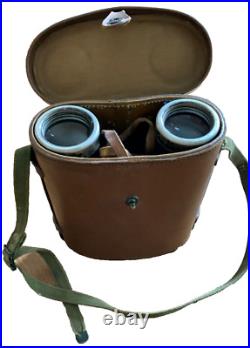
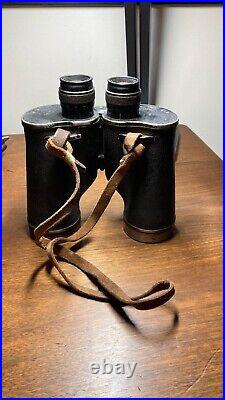
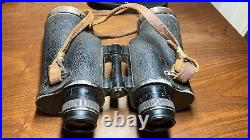

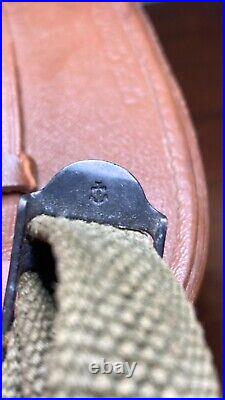
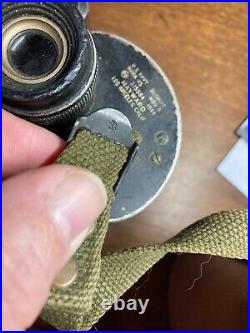

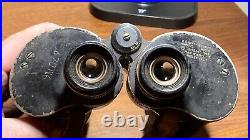
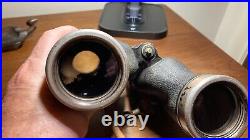
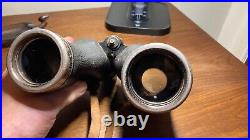
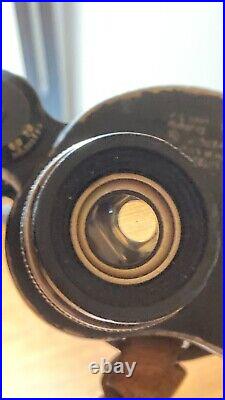
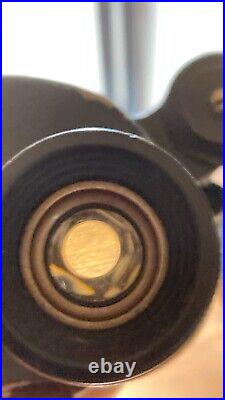
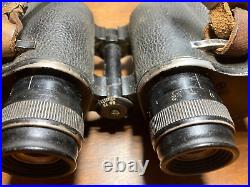
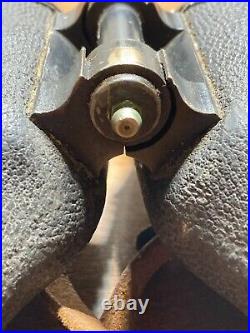
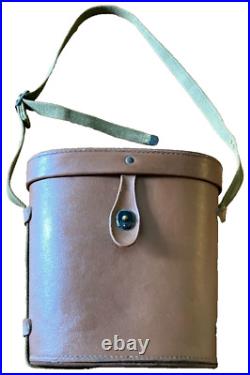
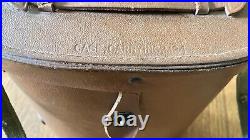
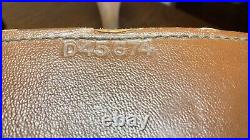
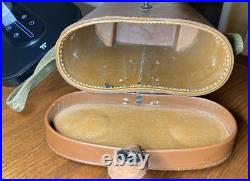
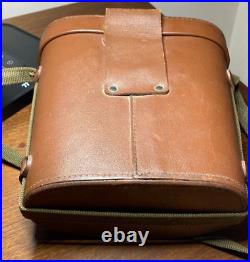
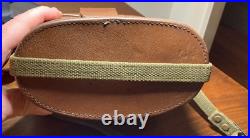
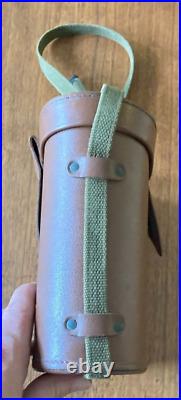
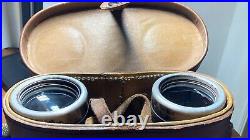
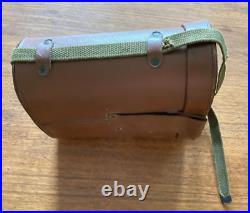

WW2: USN SUBMARINER MARK 45 HAYWARD MFG BINOCULARS W/MINT OPTICS & MINT USN CARRY CASE- READ/SEE. MOTE THAT THESE MARK 45'S ARE ACTUAL WAR-TIME MANUFACTURED.
ALSO ETCHED ON THE LEFT IS ISSUE # I. NAVY BUSHIPS MARK 45 MOD 0 7X50, Field of View: 7 deg 10 min = 124.5 m/1,000 m; APFOV 50.12 deg, Weight: 1316 gr, Exit Pupil: 7.14 mm, Serial #/Year of Manufacture: 315584 =1944. The left optic is fixed, the right optic is adjustable.
NOTE THAT THESE MARK 45'S ARE ACTUAL WAR-TIME MANUFACTURED. Notes: Below taken from wpgbinocular.
Contrary to reports, the Navy Mark 45 was not manufactured by a lumber company contracted to manufacture binoculars. Given this type of company, Rohan's statement that due to shortages of Bausch & Lomb glass Hayward provided their own optical glass for the Mark 45 sounds accurate. The Mark 45 was introduced in 1943 and because of its sturdy build and waterproofing (to say nothing of its excellent optics) was used on submarines and by underwater demolition units as well as reportedly during the Alamogordo nuclear tests and.
After the war, by NASA space capsule recovery teams. Although the Mark 45 is basically a Bausch & Lomb build type binocular as were most U. 7X50 WW II binoculars, there are some important differences which distinguish it from the others: 1 All joints are rubber gasket or O ring sealed making it the most waterproof U. WW II 7X50 binocular; 2 The prism shelf assembly is attached to the prism plate instead of the body most likely for improved shock proofing. The Bausch & Lomb Mark 41 and Sard Mark 43 are also built this way; 3 The body is drawn aluminum making it more lightweight and giving it a slimmer profile; 4 The front hinge has a Zerk-type grease nipple for lubrication.As well, all Mark 45's had anti-reflective coated optics as did many later war American binoculars. NUMBER ETCHED IN RIGHT FRONT- READS 670W6. MARK45 BINOCULARS COME WITH A NEAR MINT- ORIGINAL CASE: CASE IS STAMPED: "CASE, CARRYING M24" AND TYPE: D45874. The adjustable WW2 ISSUE NYLON case strap. HAS A CLEARLY STAMPED U.
NAVY ANCHOR ON IT - And is made highly malleable NYLON MATERIAL Which is correct for an original issue. THE ORIGIBAL WW2 ISSUED CASE FOR THESE HAYWARD MARK 45'S WOULD HAVE BEEN A HARD CASED PLASTIC OVER THE M24 7X50 SERVICE CASE. Eather Carrying Case M24 D45874 Dimensions. Top is 8.5 long.Bottom is 7.25" long x 8.25" high. Top is 4.5" deep/ Bottom is 3.5" deep. This WWII brown leather Carrying Case M24 / D45874 has an adjustable strap with an 18.5" - 35" shoulder drop as well as a wide leather belt loop on the back. The case is structured and has a push button front closure with printing that reads: Lift Button Up.
The exterior has a very nice patina - clearly stored carefully. The Mark 45 were issued with a HARD hard rubber carry case, and with nylon carry straps for the binocular and for the case. MORE DATA ON THE HAYWARD MARK 45. While a number of other companies manufactured binoculars for other services or for branches of service and even for other Bureaus of the Navy, the manufacturers contracted to fabricate 7x 50 Porro binoculars during World War II specifically for the BUSHIPS include.
Anchor Optical Corporation, New York, New York. Bausch & Lomb Optical Company, Rochester, New York. Hayward Lumber & Investment Co. Chemical & Manufacturing Division, Los Angeles, California. National Instrument Corporation, Houston, Texas.Optical Film & Supply Co. SARD Square D Company Kollsman Instrument Company, Inc.
, Elmhurst and Flushing, New York. Spencer Lens Company (division of American Optical Company), Buffalo, New York. Universal Camera Corp, New York, New York.
Once a new requirement was identified the government would solicit proposals, at times even paying for some of the upfront costs of design. After the designs were approved then the detailed production drawings (blueprints) would be prepared that included: Outline View (exterior), General Arrangement, and Optical Arrangement. A "General Arrangement Mark xx " number was assigned to the manufacturing drawings and to the contract paperwork.
The suffix of each number indicated the originator, with O indicating BU. ORD, S indicating BUSHIPS, C indicating a customer's drawing. A General Arrangement letter suffix might indicate it originated in the Navy even if it was made for the another branch of service, the U. This process facilitated distributing the necessary design information that would insure consistency among the various assigned manufacturers. In time the contracting process changed from referring to these items by General Arrangement number and instead assigned a Federal Stock Number (FSSN) to each product. A Brief Diversion - The Mark 45. 0 by SARD, and the. 0 designed and produced by Hayward Lumber & Investment Co.Chemical & Manufacturing Division, Los Angeles, California, were the last two war time new handheld 7x 50 binocular production contracts issued by the U. Prior to that, Hayward and their subsidiary Ackerman Boat had been awarded contracts to build small craft. Was awarded contracts to manufacture optical glass and provide optical supplies.
The Mark 45 entered production in mid-1944, it is similar to the general purpose U. Military service 7x 50 binoculars, even sharing some components. So the quality of view, and the fifty-one-degree apparent field of view observed through the Mark 45 are comparable to the B&L Mark 28 Mod 0, SARD Mark XLIV, and most other U.
The differences between the Mark 45 and others of this era are in their mechanics. Among those who appreciate the aesthetics of optical instruments, the. Is just about the sexiest looking 7x 50 military binocular ever made; it's streamlined form is possible because the body is manufactured of drawn aluminum. This is a more costly manufacturing process than casting, but one that results in a slimmer profile and with lighter weight yet with strength similar to that of castings.Interesting mechanical differences include the carry strap loop of the Mark 45, each is machined from a solid block with a slot for the carry strap and with an elongated oval form precisely fit to match the curve of prism housing. The strap loops of most other hand-held binoculars of this era are more of a rectangular form. 0 binocular with provided nylon carry strap, note the form fitting machined strap loops and the prominent coated optics warning label on left prism cover (102,160 bytes).
From Company Seven's museum exhibit. Each side of general purpose 7x 50 models incorporate two prisms attached to a supporting Prism Plate (termed Cluster), these are bolted to the body casting. The prisms supports of the Mark 45 and of the. Bausch & Lomb Mark 41. And SARD Mark 43 too differ from other U. Military binoculars of this era in that they are affixed to a Prism Plate, that Cluster is affixed by three Prism Posts to a support plate and that assembly is attached to the rubber gasketed eyepiece and prism cover assembly. This arrangement increases resistance of the prisms to fracturing, or the shifting of their alignment (collimation) from an impact or shock.The Mark 45 hinge axle is a ratchet type for adjustment of tension that differs from conventional models in the way in which tension is exerted, while the forward end of the hinge differs from other 7x 50 models in that it incorporates a. The Mark 45 weighs 2.89 lbs. While the SARD Mark XLIV weighs 2.92 lbs. And the B&L Mark 28 weighs 2.98 lbs. So these are all similar in that aspect.
There are some mentions that the Mark 45 may withstand greater water pressures or stress than most 7x 50 models, a U. Navy Manual from 1951 mentions this is the most waterproof of all the binoculars. Designed for underwater service to withstand water pressure where the other binoculars will not, it is used on board submarines and by demolition teams; to Company Seven eye's this may have resulted from misinterpretations and some myths about the Mark 45. Interestingly enough, the Navy BUSHIPS (later NAVSHIPS) technical maintenance and repair manuals in our archives refer to the Mark 45 model as having to pass only the same waterproofness testing as that of other U.
Since all general purpose Navy 7x 50's met the same water proofness testing standard, and as lookouts of many vessels were subjected to sea spray and waves, we at Company Seven suspect the association with submarines may have had more to do with the Mark 45's superior resistance to failing from impact owing to its prisms housings mechanical arrangement. Submariners moved quickly when the General Quarters or dive alarms sounded, and in their haste to clear hatches (going below) a dangling binocular would be at risk to strike metal. Superior resistance to damage from impact could have made the Mark 45 better suited than most other 7x 50 binoculars for use by submarine crews. Of course seven decades later, we have not met anyone who was there who can confirm any of this.
It requires some luck to find a Mark 45 that is not bound up by old grease, or beat to heck from hard use; used examples do tend to pop up for sale from time to time and some are in good to near new condition. "No amateur should attempt to disassemble and clean or repair any of these binoculars. SIZE DATA IN CASE: WEIGHT 4.75 POUNDS- WILL BE PLASTIC SEALED & BUBBLE WRAPPED.